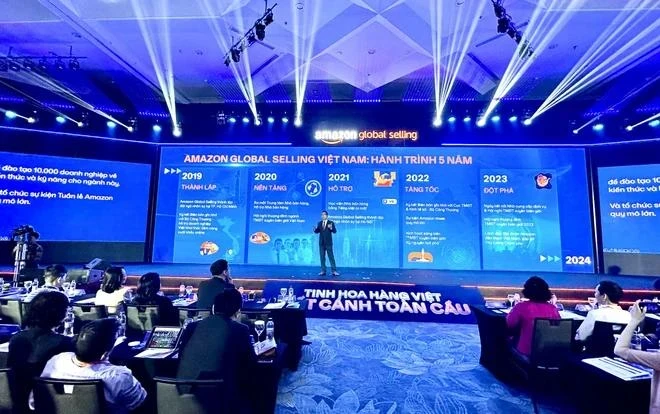E-commerce opens door wider for Vietnamese brands to global markets
Cross-border e-commerce has helped increase the number of products sold by Vietnamese sellers on Amazon and their revenues have rose by tens of times over the last five years, according to Amazon Global Selling Vietnam (AGSV).
The Cross-border E-commerce Summit 2024, which opened on May 22 in Hanoi, placed emphasis on a forward-thinking approach in embracing cross-border e-commerce as an opportune means to elevate Vietnamese enterprises and brands onto the global stage, thus reinforcing import-export activities.
Success from global trade connections
The event, themed 'The Quintessence of Vietnamese Goods Soaring Globally,' was organised by AGSV in coordination with the Vietnam E-commerce and Digital Economy Agency (VEDEA) under the Ministry of Industry and Trade (MoIT).
Statistics of the MoIT showed that retail e-commerce turnover has grown at an average rate of about 20% over the past decade, propelling Vietnam into the list of the fastest-growing e-commerce markets in the region and the world.
The forum also highlighted a series of promising outcomes, showing that the recent explosion of e-commerce has created many opportunities for Vietnamese businesses to access international markets and boost import-export activities. Ngo Sy Hoai, Vice Chairman and Secretary General of the Vietnam Timber and Forest Products Association (VIFOREST), noted that Vietnam's wood industry has experienced continuous growth for 20 years, with an annual growth rate of over 10%.
Vietnam has become one of the world's leading centres for wood processing and trading, he added.

Vietnam ranks second in the world, after China in exporting interior and exterior wood products, with its export turnover reaching nearly 5 billion USD in the first four months of 2024, up 23.7% year-on-year.
The wood industry is said to be one of the top sectors utilising e-commerce effectively, with sale revenue on this platform among the top in Vietnam, Hoai said.
For the textile and garment industry, e-commerce remains one of the fastest means to reach consumers and an effective solution for businesses to build their brands.
According to Truong Van Cam, Vice Chairman and General Secretary of the Vietnam Textile and Apparel Association (VITAS), the textile and garment industry is also among the top five sectors recording stable cross-border e-commerce growth.

Statistics showed that the industry earned 12.5 billion USD from exports in the first four months of 2024, up 7% compared to the same period last year.
He emphasised Amazon's role in enabling direct customer access for textile products, affirming Vietnam's position with competitive pricing, quality and fast delivery.
Cam expressed his hope for Amazon to assist businesses in identifying strengths and weaknesses and enhancing value chain processes to further succeed in e-commerce.
Further promoting global online presence
Phan Van Hieu, Chairman of the Board of Directors cum General Director of CVI Pharma, said this time is a great opportunity for businesses to shift to multi-channel sale and directly export to the global market, adding that by joining cross-border e-commerce, enterprises can easily access new markets.
Gijae Song, CEO of Amazon Global Selling Vietnam, said that in the past five years, the number of products sold by Vietnamese partners on Amazon has increased by over 300%, while the number of Vietnamese businesses achieving 1 million USD in revenue per year on Amazon has increased nearly tenfold.
The global e-commerce market is expected to grow rapidly, with estimated revenues reaching 7.4 trillion USD by 2025. Against the backdrop of Vietnam’s deepening integration into the global economy, coupled with opportunities from new-generation FTAs, the trend of transitioning from traditional business to digital platforms is seen as an effective way for businesses to penetrate into and expand export markets.






